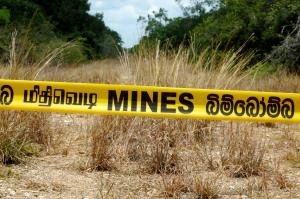
Publisher:
Bonnie King
CONTACT:
Newsroom@Salem-news.com
Advertising:
Adsales@Salem-news.com

~Truth~
~Justice~
~Peace~
TJP
Feb-08-2012 12:51

 TweetFollow @OregonNews
TweetFollow @OregonNews
SRI LANKA: Mine Clearance Could Take 10 Years or More
Salem-News.comThe UN Children's Fund (UNICEF) carries out mine risk awareness programmes in the north and east.
 About 126 sqkm of land remains to be cleared Photo: Amantha Perera/IRIN |
(COLOMBO) - Landmine clearance in Sri Lanka's conflict-affected north could take more than a decade, experts say.
"It is expected to take [in] excess of 10 years to fully mitigate all remaining contamination in Sri Lanka," the Mine Action Project of the UN Development Programme (UNDP) in Sri Lanka told IRIN, citing a lack of resources coupled with the difficult nature of the work.
Approximately 126 sqkm of land remains to be cleared in the island's north at the end of 2011, according to data from the National Mine Action Centre (NMAC).
Set up in July 2010, NMAC is the government's lead agency in de-mining work in the country.
As of 31 December 2011, the largest remaining area was in Mannar District (33.8 sqkm), followed by Mullaitivu (27.7 sqkm), Kilinochchi (23 sqkm), Vavuniya (15 sqkm) and Jaffna (5 sqkm) in the north.
Smaller areas are in borderline districts of Polonnaruwa and Anuradhapura, along with some parts of the east.
Barrier to return
More than 6,700 conflict-displaced, mainly from Mullaitivu District, continue to live at Menik Farm outside the town of Vavuniya, where more than 200,000 internally displaced persons (IDPs) once lived following the end of the war between government forces and the Liberation Tigers of Tamil Eelam (LTTE), which had been fighting for an independent Tamil homeland since 1983.
According to the UN Office for the Coordination of Humanitarian Affairs (OCHA), since 1 January 2009, more than 554 sqkm have been cleared of mines and UXO (unexploded ordnance) in the north and east of the country.
The humanitarian demining unit of the Sri Lanka Army, international organizations - Danish Demining Group (DDG), HALO Trust, Horizon, Mines Advisory Group (MAG), Sarvatra, and Swiss Foundation for Mine Action (FSD)] - and two national organizations - Delvon Assistance for Social Harmony (DASH) and the Milinda Moragoda Institute for Peoples' Empowerment (MMIPE)] - are engaged in demining work.
The UN Children's Fund (UNICEF) carries out mine risk awareness programmes in the north and east.
The UNDP Mine Action Unit said most of the surveys to identify the mine risk areas had been completed, but the task of clearing the mines and UXO remains time-consuming and labour-intensive.
"It turns out there aren't any fancy scanners or high-tech mine-removal gadgets that can compete with old-fashioned sweat, discipline, and patience when it comes to picking mines out of the ground," US diplomat Emily Fleckner said during a December site visit to Kilinochchi, where some of fiercest fighting once took place.
Fleckner wrote in a blog post for the State Department that officials with HALO Trust told her the organization had removed more mines in Sri Lanka during its first year of operation than all its other de-mining work combined worldwide over the same period of time.
Funding questions
But it is the overall issue of funding that has people worried most almost two years since the war was officially declared over.
UNDP’s Mine Action Project says the slow work of removing mines was “compounded by decreasing donor funding” for themselves and other mine clearance agencies.
On 22 January, DDG said in an update that it had been forced to reduce its capacity by 20 percent since late 2010 due to funding constraints.
DDG doubled its clearing capacity soon after the war ended in May 2009. "[But], in late 2010/early 2011 this was followed by an unheralded decrease in funding, especially amongst our major donors who reviewed their strategies globally and in particular towards Sri Lanka."
The group has since warned of further reductions if funding constraints persist.
NMAC estimates it will cost more than US$100 million to demine the last 126 sqkm.
Meanwhile, for those who have returned to their places of origin, the need to remain vigilant continues.
"We know they are still around," Mathiyavaratham Manivannan, a 32-year-old farmer in Mullaitivu District said, noting that mine-awareness programmes had made it easier for him to identify mines and UXO. "We don't find them that often now, but we do come across them, especially when we clear new land."
According to UNICEF, mine-related incidents were on the decline due to intense awareness programmes. More than 23,000 returnees took part in such programmes in December 2011 alone, with mine risk education continuing in both the north and east of the country, OCHA reported.
In 2011, only 17 mine-related incidents were reported, down from 27 a year earlier. The casualty rate also dropped from 47 to 24.
Special thanks to IRIN- humanitarian news and analysis a service of the UN Office for the Coordination of Humanitarian Affairs
http://www.irinnews.org/printreport.aspx?reportid=94798
[This report does not necessarily reflect the views of the United Nations]
 |
 |
 |
 |
 |
Articles for February 7, 2012 | Articles for February 8, 2012 | Articles for February 9, 2012
Quick Links
DINING
Willamette UniversityGoudy Commons Cafe
Dine on the Queen
Willamette Queen Sternwheeler
MUST SEE SALEM
Oregon Capitol ToursCapitol History Gateway
Willamette River Ride
Willamette Queen Sternwheeler
Historic Home Tours:
Deepwood Museum
The Bush House
Gaiety Hollow Garden
AUCTIONS - APPRAISALS
Auction Masters & AppraisalsCONSTRUCTION SERVICES
Roofing and ContractingSheridan, Ore.
ONLINE SHOPPING
Special Occasion DressesAdvertise with Salem-News
Contact:AdSales@Salem-News.com

googlec507860f6901db00.html



Terms of Service | Privacy Policy
All comments and messages are approved by people and self promotional links or unacceptable comments are denied.
[Return to Top]
©2025 Salem-News.com. All opinions expressed in this article are those of the author and do not necessarily reflect those of Salem-News.com.